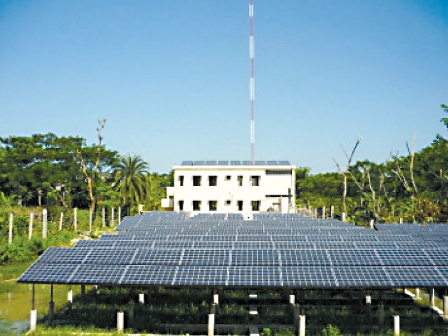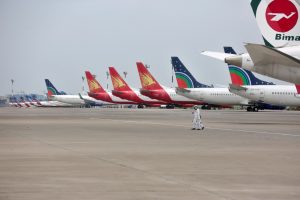Zulker Naeen
The spread of the off-grid power solution in Bangladesh started in 2003 using the stand-alone photovoltaic systems, known as the solar home systems. By 2017, the country installed 5.2 million solar home systems that offer a cost-effective mode of supplying power to remote off-grid households. The custom-made solar home systems had a total capacity of 218 megawatts, according to the “Renewables 2018-Global Status Report”, released by Paris-based energy think-tank REN21 in June.
According to the report, Bangladesh is the second highest user of solar home systems now after India.
About 17 million households use solar home systems covers 13 per cent of the total population.
To achieve the goal of being the world’s “first solar nation”, the government aimed to generate 10 per cent of its total power generation capacity by 2021, meaning 2400MW power generation from renewable sources.
In the context of national power demand and generation, the contribution of solar home systems is tiny, a mere 2 per cent of the total power generation capacity. In other countries, the solar system is connected to the national grid, but we are yet to successfully connect the solar system to our grid system.
Currently, the wind power capacity is about 2MW, the bio-energy capacity is about 1MW. Therefore, the growth of renewable energy in Bangladesh is relying on the development of on-grid solar power.
According to SREDA, at present, the on-grid solar power generation capacity amounts to only 15MW.
Till now, only a solar park with 3MW capacity has built on 8 acres of land in Sarishabari in Jamalpur district. However, the government has already approved the proposals for establishing 19 on-grid solar power parks submitted by different private companies.
The capacity of the proposed solar parks ranges from 5MW to 200MW individually and the cumulative power generation of all these installations would amount to 1070MW.
Only six companies of them have so far reached the final stage of negotiations by signing the power purchase agreement (PPA) and implementation agreement with the government.
None of the companies could complete construction and start power generation within the deadline, one and a half years from signing the power purchase agreement (PPA) and implementation agreement.
Therefore, the development of the on-grid solar has so far failed to ignite hope of achieving projected government target. In reality, what holds Bangladesh back in developing the on-grid solar? There are a number of reasons that are restricting the development of the on-grid solar.
Acquiring the land for solar is one of the major challenges, as per the government rule, no agricultural land can be used for the solar power project. For example, A 100MW solar park would require about 300 acres of land.
The development of the on-grid solar is on hold partially because of the lack of government incentive. The companies engaged in negotiations and implementation of the solar park as well as the solar industry is still in an immature and infant stage. The solar power tariff is another concern.
So, the solar power industry in Bangladesh is yet to stand on its own feet. The challenges in developing renewables may be high, but the government should extend its hand to help it grow to balance the existing energy mix. However, the success we are publicizing about the off-grid renewable energy scheme is not an actual one until our solar system is not turned into the on-grid solar.
(Zulker Naeen is a South Asia Fellow at Climate Tracker. )




